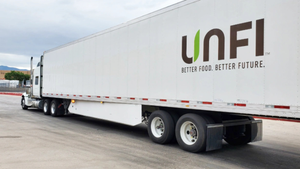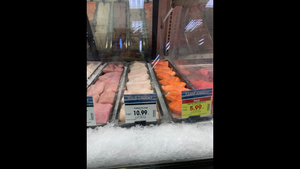Smart & Final posts Q4 loss, sees cannibalization slowing
Record number of store openings in 2016
March 10, 2017
Smart & Final Stores said cannibalization from new-store openings, along with deflation in several major categories, blunted sales growth in the fourth quarter.
The Commerce, Calif.-based warehouse-style retailer reported a loss of $300,000 for the 12-week period, which ended Jan. 1, after expenses for new-store openings, three store closings and other factors. Net income in the year-ago period, adjusted for an extra week a year ago, was $10 million.
Sales totaled $1 billion in the period, up 9.2% over year-ago fourth-quarter sales, also adjusted for an extra week in fiscal 2015. Sales growth was driven by new stores, partially offset by a 2% decrease in comparable-store sales.
The 2% comp decline included a 2.2% decrease in transaction size and 0.2% increase in transaction count.
Deflation in the fourth quarter totaled 2.1%, which included 16% deflation in dairy and eggs (which comprise 6% of sales), 4% deflation in meat and 5.6% deflation in produce.
“The good news about deflation, if there is any, is that it’s not nearly as widespread as it was in the early parts and middle of last year,” said Dave Hirz, president and CEO, adding that the company is projecting deflation to abate in the “middle of the year.”
The company opened 33 Smart & Final Extra! stores in 2016, converting a group of supermarkets it had acquired from Haggen. It finished the year with 305 stores, including 172 under the Extra! Banner, 74 legacy Smart & Final locations and 59 Cash & Carry units.
“I know the cannibalization was painful this year, but we still think it’s a good tradeoff,” said Hirz. “We would do it again tomorrow.
“When you can double your store presence in a really critical area like San Diego from 13 to 27 stores, and the type of density we now have in [Los Angeles] and the Central Coast, it is really working well for us. It’s helping with our messaging, our branding, our marketing.”
Going forward, the company expects to continue to grow new stores at a pace of about 10% annually, but the stores will be more spaced out geographically, he said.
“We think cannibalization in Smart & Final will return to a more normalized 50 [basis] point-a-year level,” said Hirz.
For the full year, Smart & Final posted net income of $12.9 million, vs. $38.3 million a year ago. Adjusted net income was down 25%, to $42.2 million, compared with $56.3 million in fiscal 2015.
Sales for the year were up 9.3%, to $4.34 billion. Adjusted for the extra week in 2015, sales were up 11.2%. Comps for the full year fell 0.5%, which included a 0.8% increase in transaction count and a 1.3% decrease in transaction size.
Smart & Final projected sales growth for 2017 of between 5.5% and 6.5%, with comp-store sales up 1% to 2%.
John Heinbockel, an analyst with Guggenheim securities, lowered his price target on Smart & Final shares after the earnings report, to $16 per share, from $17, and maintained a “buy” rating, according to a StreetInsider report.
“Both cannibalization and deflation should dissipate over the next year, with the old secular algorithm — 10%-plus sales and EBITDA growth — reappearing,” he was quoted as saying.
Organics, private label strong
Sales of natural and organic product were a strong point in the fourth quarter, the company said, with sales of organic items up 16% on a comp-store basis. Smart & Final now offers 1,400 natural and organic products across 29 different categories.
The company’s Sun Harvest natural and organic private label saw sales increase 57% in the fourth quarter.
Smart & Final also carries the First Street private label, which comprises about 78% of its total private label sales, and Simply Value, an entry-price-point brand that comprises 6% of private-label sales.
“Most of the innovation in 2016 went into First Street and Sun Harvest,” said Hirz, noting that Sun Harvest generates higher margins.
“We used to say we had a 600-point incremental margin in private label, [but] that gap is now 750 points, and a lot of that is really being driven by the growth of Sun Harvest,” he said.
The company is also continuing to test several new merchandising initiatives, including cut fruit, craft beer, gourmet cheese, hot bakery and sushi.
About the Author
You May Also Like




